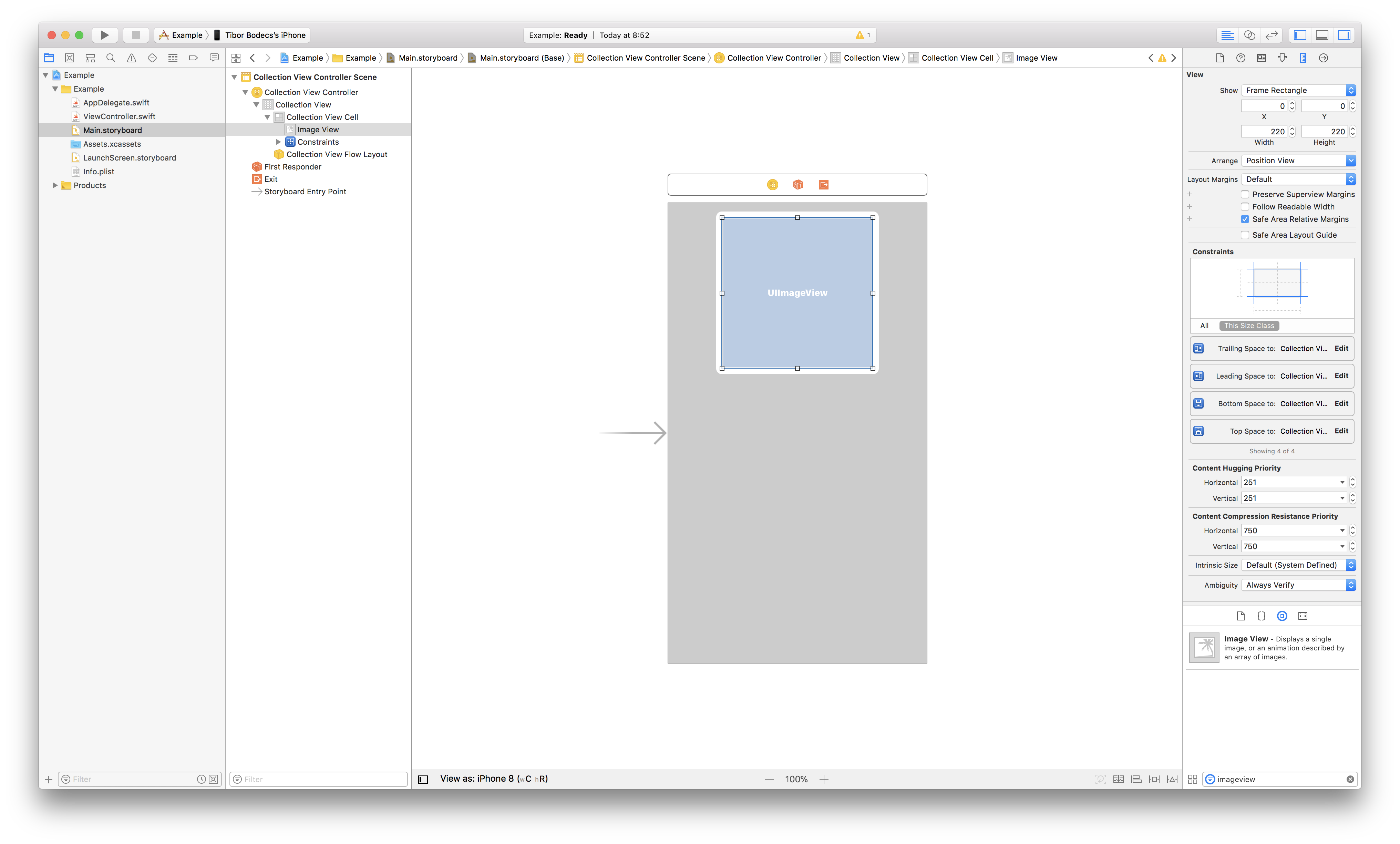Round cells inside a set view
Attaining the aim is comparatively simple, but when you do not know what is going on on within the background it may be more durable than you’d assume first. So let’s create a brand new challenge add a storyboard with a UICollectionViewController, drag a UIImageView contained in the cell, resize it, add some constraints, set the cell identifier.

It ought to look one thing just like the picture above. Nothing particular only a easy UI for our instance software. Now seek for some random picture, add it to the challenge and let’s do some actual coding. First I will present you the little trick inside the cell subclass.
class Cell: UICollectionViewCell {
@IBOutlet weak var imageView: UIImageView!
override var bounds: CGRect {
didSet {
layoutIfNeeded()
}
}
override func awakeFromNib() {
tremendous.awakeFromNib()
imageView.layer.masksToBounds = true
}
override func layoutSubviews() {
tremendous.layoutSubviews()
setCircularImageView()
}
func setCircularImageView() {
imageView.layer.cornerRadius = CGFloat(
roundf(Float(imageView.body.measurement.width / 2.0))
)
}
}Are you able to see it? Sure, you must override the bounds property. As the subsequent step we now have to jot down the controller class with some primary knowledge supply for the gathering view and with the correct assist for the rotation strategies. 🤓
class ViewController: UICollectionViewController {
override func collectionView(
_ collectionView: UICollectionView,
numberOfItemsInSection part: Int
) -> Int {
30
}
override func collectionView(
_ collectionView: UICollectionView,
cellForItemAt indexPath: IndexPath
) -> UICollectionViewCell {
let cell = collectionView.dequeueReusableCell(
withReuseIdentifier: "Cell",
for: indexPath
) as! Cell
cell.imageView.picture = UIImage(named: "Instance.jpg")
cell.imageView.backgroundColor = .lightGray
return cell
}
override func traitCollectionDidChange(
_ previousTraitCollection: UITraitCollection?
) {
tremendous.traitCollectionDidChange(previousTraitCollection)
guard
let previousTraitCollection = previousTraitCollection,
traitCollection.verticalSizeClass != previousTraitCollection.verticalSizeClass ||
traitCollection.horizontalSizeClass != previousTraitCollection.horizontalSizeClass
else {
return
}
collectionView?.collectionViewLayout.invalidateLayout()
collectionView?.reloadData()
}
override func viewWillTransition(
to measurement: CGSize,
with coordinator: UIViewControllerTransitionCoordinator
) {
tremendous.viewWillTransition(to: measurement, with: coordinator)
collectionView?.collectionViewLayout.invalidateLayout()
coordinator.animate(alongsideTransition: { context in
}, completion: { context in
collectionView?.collectionViewLayout.invalidateLayout()
collectionView?.visibleCells.forEach { cell in
guard let cell = cell as? Cell else {
return
}
cell.setCircularImageView()
}
})
}
}
extension ViewController: UICollectionViewDelegateFlowLayout {
func collectionView(
_ collectionView: UICollectionView,
structure collectionViewLayout: UICollectionViewLayout,
sizeForItemAt indexPath: IndexPath
) -> CGSize {
.init(
width: collectionView.body.measurement.width/3.0 - 8,
peak: collectionView.body.measurement.width/3.0 - 8
)
}
}In case you are accustomed to assortment views, you may ask why am I doing this tutorial? It is so easy. It simply works, proper? No, really with out the overridden bounds property the instance would look one thing like this on the left aspect. 😢

Humorous, huh? The picture on the precise aspect is the precise outcome with the overridden bounds, that is the anticipated habits. Scrolling and rotation goes to be actually unusual if you happen to do not override bounds and you do not reset the cornerRadius property for the seen views. You may ask: however why? 🤔
Layers, springs & struts and a few clarification
Apple nonetheless has “Springs & Struts” based mostly code inside UIKit. Which means body and sure calculations are occurring within the underlying system and the constraint system is attempting to work laborious as properly to determine the correct measures.
“Springs & Struts” must die!
Whereas there may be an init(body:) technique, or a required init(coder:) these structure issues will suck as hell. I actually like Interface Builder, however till we can’t get a positive device to create nice person interfaces IB goes to be simply one other layer of potential bugs.
This situation will not even be there if you happen to create the cell from code solely utilizing auto structure constraints or structure anchors! It is as a result of IB creates the cell based mostly on the body you gave in whilst you designed your prototype. However if you happen to neglect init(body:) and also you simply create a brand new UIImageView occasion and let auto structure do the laborious work, the structure system will resolve every little thing else. Examine this.
class Cell: UICollectionViewCell {
weak var imageView: UIImageView!
required init?(coder aDecoder: NSCoder) {
fatalError("init(coder:) has not been applied")
}
override init(body: CGRect) {
tremendous.init(body: body)
translatesAutoresizingMaskIntoConstraints = false
let imageView = UIImageView()
imageView.translatesAutoresizingMaskIntoConstraints = false
addSubview(imageView)
imageView = imageView
imageView.topAnchor.constraint(equalTo: topAnchor)
imageView.bottomAnchor.constraint(equalTo: bottomAnchor)
imageView.leadingAnchor.constraint(equalTo: leadingAnchor)
imageView.trailingAnchor.constraint(equalTo: trailingAnchor)
}
override func layoutSubviews() {
tremendous.layoutSubviews()
imageView.layer.masksToBounds = true
imageView.layer.cornerRadius = CGFloat(
roundf(Float(imageView.body.measurement.width/2.0))
)
}
}Clearly you must write extra code, register your cell class manually contained in the controller class and also you additionally must override the layoutSubviews technique contained in the cell, however it’ll work as it’s anticipated. 🙄
collectionView?.register(Cell.self, forCellWithReuseIdentifier: "Cell")Anyway, after you register the programmatically created cell you may have a pleasant means of displaying round pictures. Utilizing this method is sort of tough, however it undoubtedly works in each case. You’ll be able to obtain the instance from The.Swift.Dev. tutorials on GitHub.

